VOL. XV NUMBER 2 ASSOCIATION NEWSLETTER NOVEMBER 2009
A veteran – whether active duty, retired, national guard or reserve – is someone who, at one point in his life, wrote a blank check made payable to “The United States of America,” for an amount of “up to and including my life.”
ODDS and ENDS
On February 19, 2009 a non-veteran author died from lung cancer. Keith William Nolan was 44 years old. He authored 14 books about the Vietnam War. His book Death Valley recounts the events that occurred in August 1969 in the Hiep Duc Valley. Many of you were a part of that action. Nolan’s writings bring the terror to life in a compelling manner. His was a voice of the Grunt who endured a miserable life. This editor recommends any of Nolan’s work about Vietnam. Rest in peace!
Tony Jones (EM 70-71) has made a request of the men from his era. Tony was (and still is) an artist of renown who painted the elaborate nose art snakes and other nose art items for the crews. There is a man named John Brennan who served in the 114th AHC and is putting together a book of Vietnam helicopter nose art and helicopter names. If you would sent a photo of any such art you may have to John Brennan at johnmailman@yahoo.com or to Tony at jonesantho@aol.com they could use it and also get a little PR for Tony’s work.
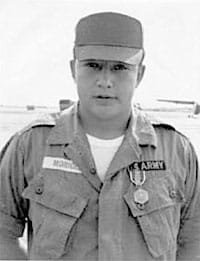
Jacque Morigeau
In our photo section, Jacque Morigeau (EM 65, also listed in Taps section) is shown with early Rattler nose art. Our first platoon was then known as the “Esquires” and Jacque designed the nose art depicting this. By October 1966 when Ron Seabolt arrived in the company, we were only using the Rattler snake on the nose, but the Esquires emblem was still being used in our barracks area (Bailey Compound), then after December 1, 1966 outside our “tent city” area after the enlisted men were all booted from Bailey Compound for use by ARVNs.
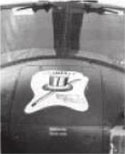 When we moved to Chu Lai on April 18, 1967, the Esquires logo was placed in Seabolt’s cargo door window and “Isky”, our platoon dog also rode on this aircraft. Seabolt has no memory whatsoever of what happened to either the logo or “Isky” after reaching Chu Lai. One can only imagine what happened to Isky.
When we moved to Chu Lai on April 18, 1967, the Esquires logo was placed in Seabolt’s cargo door window and “Isky”, our platoon dog also rode on this aircraft. Seabolt has no memory whatsoever of what happened to either the logo or “Isky” after reaching Chu Lai. One can only imagine what happened to Isky.
Sometime later the Esquires of the 1st platoon became known as the Widowmakers and the 2nd platoon, who were known as the Phantoms, became known as F-Troop.
Jacque Morigeau was a Native American of the Flathead Nation who was a prominent member of his tribe in Montana until his death on November 8, 2008 of cancer.
NEWSLETTER BACK ISSUES
There is a demand for back issues of some of our newsletters from our men. The following issues are available while supplies last: ’98 May & November, ’99 May & November, ‘00 November, ’01 May & November, ’02 May & November, ’03 May & November, ’04 May & November, ’05 May & November, ’06, May & November, ’07 May & November, ’08 May & November and ’09 May. This is 22 issues total. The price is $3 per issue, (all prices including postage), 2 issues – $5, 3 issues – $6, 4 issues – $7. Complete 22 (minus May 2000) issue set – $40.
Webmaster’s note: All back issues are available for free here on our web site in the newsletter section.
NASHVILLE REUNION – MAY 12 – MAY 16th
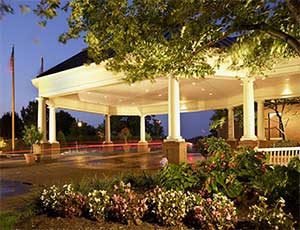
IMPORTANT: The cutoff date for our block of hotel rooms and the Military Reunion Planners Registration is April 9, 2010. Please make your reservations well before this date to insure getting a reservation and it helps our Association to be able to know we can “make” our numbers.
There will be a continental breakfast daily served in our Hospitality Room plus we will be bringing in snacks later around lunch. As always we will have assorted FREE drinks. This should help defray your meal costs as always at our reunions. The hotel offers a nice dining menu, but there are no other dining facilities within walking distance of the hotel.
An “early bird” tour, the General Jackson Lunch Cruise, is being offered on Thursday for the 1st time. If it sells (minimum 30) we can continue having a Thursday tour in the future. A special event and one of a kind opportunity will be for the group to take buses to the Grand Ole Opry on Friday night, seated together. The “Opry” is about a ten minute drive from the hotel.
The “Firebird Freefire” Golf Outing will again be held on Friday morning at the Gaylord Springs Golf Links located at 18 Springhouse Lane, Nashville. This is about 7 miles from the hotel.

Michael Durant
Cost of play is $70 per player with club rental available for $50. This covers green fees and cart rental only. Note they have a strict dress policy (no shorts, other than Bermuda style/length, no cut-offs, no T-shirts, no tank tops, no athletic gear and no denim). See their website at www.gaylordsprings.com . Players will be permitted to pay Vic Bandini individually on the day of play. Please confirm all golfers to Vic no later than April 16, 2010 at phone #317-201-4800 or firebird99@juno.com . Vic has suggested the players meet in the hotel lobby at 6:30 am.
Our Saturday night banquet speaker will be Michael Durant. Durant was one of the Blackhawk pilots (the only survivor) depicted in the movie “Blackhawk Down” and was a POW for 11 days while suffering a broken back, compound leg fracture and shoulder gunshot wound.
At Nashville, following our Saturday morning Memorial Service, an Association business meeting will be held. One item on the agenda will be the election of one new member of the Board of Directors because of the four year term limit of “at-large” members. James Malone will be leaving the board at this time. If you wish to run for this position, to nominate someone or to vote in this election, you must be a dues paying member in good standing and your nominee must also be a dues paying member. Our dues are $12 per year or a sliding scale life membership fee of ages: 56 – 60 $150, 61 – 65 $125, 66 and up $100.
PTSD CAN MAKE YOU BOTH LAUGH AND CRY
A Note to the Rattler/Firebird Wives by Kay Seabolt
It was the Friday before Christmas 2008 when Ron and I were sitting at a snack bar sipping sodas through straws in a Bass Pro Shop of all places. We were killing time before our drive back home from Grapevine, Texas. I had conned Ron into taking me to the Gaylord Texan to see the Christmas decorations and the famous Ice Sculptures. We were waiting for the never ending rush hour traffic to ease up before starting home. In front of us was one of those cute little faux creeks where the fish were swimming freely. If you can call being in an oversized fish bowl swimming freely. We were laughing at each other and reminiscing about old times. Ron jokingly said he only dated four women and married three of them. One of his favorite things to tell me is “I’m the best you could do.” This is usually after he belches, sings at the top of lungs, whistles so shrill me makes my ears hurt, or one of the other scores of other things he does to purposely annoy me.
I said, “Who would have thought that I would be married to a National Director, TV star of the History and Military channels, and noted author. I should write a book.” At which he promptly stated that I should do an article for the next newsletter. Then with that mischievous grin of his, said to make it 8 or 10 pages.
He asked me to write about the ups and downs of living with PTSD from a wife’s standpoint. A few days later I had decided that the topic of my article would be about Ron’s negative outlook on life. Using that old cliché about the glass being half empty, Ron not only thinks his glass is half empty, but that someone’s out there waiting to steal what little is left. After responding to one of his cynical remarks, I told him what I intended to write about. Can anyone guess what his reaction? How about, “If you’re going to write about that, just forget it!” My response, “Okay fine, I won’t do an article.” So here I sit at our trusty computer feeling frustrated. Such is the life with our good friend PTSD.
If my dear sweet husband would have let me finish, I would have told him that I wanted to show the humor of it. Such as the time he started a support group at the VA. On his first visit they were shown a relaxing video of the beach with the waves gently rolling in and an eagle soaring overhead. When the video was over the therapist asked if they thought it was relaxing. Everyone agreed that it was relaxing except Ron. His take on the video was that the eagle represented a buzzard looking for the bodies, sand was going to get in the intake, and if the helicopter crashed in the ocean they would have to go in on the left side. I rest my case! Living with PTSD can be funny!
As most all of the wives out there know, PTSD also has a dark side. The side that makes you cry out of frustration and makes you feel like you want to check yourself into the VA psyche unit for about a month to relax and not have to think or worry about anything other than when the next meal is coming. However, that’s the part that I can’t really share in print and continue to live in this household. All of you can probably fill in the blanks from your own story.
For those wives that are coming to the Nashville reunion next year, please try to make plans to attend the women’s meeting on Thursday afternoon at 4 pm. Linda Pitts, the wife of Archie Pitts (WO 65-66) has many years experience treating PTSD as a psychologist and did a program on PTSD for our men at San Antonio in 2006. She has kindly agreed to facilitate this women’s meeting. It will be a great time for sharing and showing support for each other.
UNLOCATED FILE
A new page was added to our website back in August named, Men We Have Been Unable to Locate. The list contains about 650 names of men we have never located and some that moved and we no longer have addresses on them. By no means do we consider the list as complete. It just represents the names we have in our files. Over the years we have obtained unit rosters (also posted on the website) and orders from our men that contain other names of our guys. This is the source of about 95% of this unlocated file. No unit rosters have been located for 1969 and 1971. If you have such a roster please send the Association a copy.
Your assistance in finding any of these men would be greatly appreciated. The unlocated list is by years, then alphabetically. In this manner, you can easily see names of the men you served with. To change the list to totally alphabetical order, simply click on “names” and the top of the list, or “years” to change it back. There is a link on the page named “ How To Locate” which offers tips for finding the men.
There are two strong reasons for this list being posted. (1) You can be involved in finding your best buddy by calling the phone numbers you get when you run a search. When an unlocated person has a common name, it thwarts the efforts of us to locate someone just because there are too many possibilities to go through. If on the other hand, I was looking for a best friend and especially if I was only looking for one person, the number of possibilities would not be such a deterrent to calling several numbers or writing letters either. (2) If one of our men (or a family member) happens to use a search engine such as Google to run their name, our webpage will pop up and hopefully, they will find us and make contact.
We are still mailing to about 1,000 men who served with us and are aware of over 1,900 total who spent time in our unit. This 1,900 breaks down as: the 1,000 on our mailing list, 55 KIAs, 209 who have died since serving with us plus the unlocated file list of about 650.
VETERANS AFFAIRS
The Association just received notification in the DAV Magazine that the VA has extended Agent Orange benefits to now cover three B cell leukemias. They are hairy cell leukemia, Parkinson’s disease and ischemic heart disease.
This brings the total number of presumed illnesses recognized by the VA to 15 ( see our web site for more info). In practical terms, veterans who served in Vietnam during the war and who have a “presumed” illness do not have to prove an association between their illness and their military service. This “presumption” simplifies and speeds up the application process for benefits.
The VA has also recently recognized a link between Agent Orange exposure and a disease named AL Amyloidosis. This rare disease is caused when an abnormal protein, amyloid, enters tissues or organs. This is not a cancer, but can occur because of some cancers. The affected organs may include heart, kidneys, liver, bowel, skin, nerves, joints, and / or lungs. Symptoms may include fatigue, weight loss, shortness of breath, numbness, tingling, and / or weakness.
All Vietnam veterans should get an Agent Orange screening at their local VA facility. This is basically a physical exam to determine the presence of any of the presumptive diseases. IMPORTANT! If any presumptive disease is detected, this does not automatically file a claim for compensation. You must do that separately, preferably using a VSO (Veteran’s Service Officer) provided by organizations such as the DAV (Disabled American Veterans), the VFW (Veterans of Foreign Wars), the American Legion or any state sponsored Veteran’s advocate organizations. Always keep copies of everything related to your claim.
Always also remember, never give up on a VA claim if you still have a means to protest an adverse ruling. They want you to quit trying. It saves them resources that you may very well be entitled to! If asked, please back up your fellow veterans with letters of support if you are aware of the action described or in the case of hearing loss, just describe what noise levels we endured on a daily basis. The more paperwork you can add to your claim, the better your chances of success. Be as tenacious as a bulldog!
Between 1966 and 1972, more than 354,000 “low-aptitude men” entered the services under a plan devised by Secretary of Defense Robert McNamara. This plan was referred to as “Project 100,000”. The guise of the plan was to offer these men another chance to learn a skill in order to improve their lot in life later. Anyone that believes this needs to buy my ocean front property in Oklahoma. Bodies were needed. Warm blooded bodies to fill the ranks. Thousands of these men wanted to join, but by the same token, thousands were drafted that did not meet either the mental or physical standards by which the military had relied upon forever.
If you believe you were in the Army under this program and are filing a VA claim, use this information by informing your Veteran’s Service Officer. If at any time you were listed by your draft board as 4-F, then later drafted, you probably went in the military under this plan.
LOST ADDRESSES
The following persons have been dropped from the Association mailing list following the May newsletter mailing due to moving or they may have died. If you happen to know for sure where any of these men now live, please inform the Association so we can put them back on the mailing list and in the address directory: Johnny J. Gray (EM 70), Luis Hernandez (EM 70-71), Marvin “Buck” Hilliard (OF 70-71), Jim McLlvenna (EM 66).
TAPS
The Association has been informed of the following deaths since our last newsletter:
- George L. Ball (EM 71) died in June 1993 of unknown causes.
- Sylvester D. Burl (EM 65-66) died on 24 November 2007 from lung cancer.
- Alfred D. Honeycutt (EM 66-67) died of unknown causes in the 90s.
- William Haines (SFC 70) died on 26 May 2000 of diabetes.
- Bill Irby (WO 70-71) died on 29 June 2009 of cancer.
- Paul Jolly (EM 69-70) died on 25 May 2009, Memorial Day, from a stroke.
- Steve Knox (EM 65-67) died on 3 October 2009 as a result of a brain tumor.
- Jacque Morigeau (EM 65) died on 6 November 2008 of cancer.
- Ronald Trussell (OF 71) died on 8 January 2007 from a heart attack.
- R.J. Williams (EM 66-67) died on 10 June 2009 of cancer.
R.J. WILLIAMS – 1st TEAM ALL AMERICAN PRANKSTER
The recent loss of R.J. Williams closes the chapter on one of the most “colorful” characters who ever served with us. In 1969, Frank Sinatra recorded his hit song “My Way”. He was a little behind the curve with that title. Ray “R.J.” Williams had been doing it “His Way” for years by then.
Many of us were fortunate to have known and served with R.J. in the Rattlers and Firebirds. Several of the cadre (officers and NCOs) were not so fortunate. R.J. served for 26 months of continuous combat in Vietnam, from August 1966 to October 1968. He was a 2nd platoon gunner, became a tech inspector in maintenance, then a crew chief in the 1st platoon. If the camp generator quit, the shower ran out of water, a typhoon hit or the club ran out of beer, the first thought of those in charge was, “R.J. did it!”
R.J. was responsible for enough mischief during his tour(s) that he needed Velcro stripes. In Vietnam, R.J. went from E-3 to E-5 to E-1 to E-5 to E-1. He was listed on our October 1968 roster as an E-1. Even when he had nothing to do with the mischief (rare), he was the first one blamed.
Chuck Carlock claimed that R.J. was the only person he ever saw in Vietnam with a bigger knife than Chuck had.
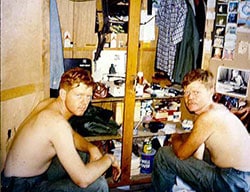
R. J. Williams and Walter Mitchell
R.J. had a very distinctive look with his red hair and large frame. Then he becomes the crewmate of Walt Mitchell, nicknamed Murphy, who could pass for his twin brother. Several times Walt was accused of doing stuff because people thought he was R.J. 1SGT Hillhouse had a standard line when weird stuff would occur, “That f—–g R.J!”
How does one man get a “rep” for having a hand in everything that can go wrong? He worked at it. R.J. believed an idle mind was meant to come up with something devious. Calm was boring. Calamity was exciting.
At one point, our Company Commander, Major Joe Bell, had his hootch “gassed”. Everyone knew R.J. did it. Except for one little thing. He was playing chess with Bill Gross when it happened. And Bill Gross’ word, a hard stripe E-5, stood for something in those days. That word saved R.J.’s stripes for another time.
Rain in Vietnam could become a “gully washer” in minutes. At one time, the enlisted men in R.J.’s unit were living in tents that had wood floors. However, the wood floors were laid on top of the ground. One night during a storm we were startled to hear a full (20 round) clip being fired through an M-16. After much confusion, it was determined that the water from the storm was gushing across the floor of R.J.s tent when he had the bright idea to make a hole for it to run out of. It made perfect sense to R.J. to empty the M-16 clip into the floor.
A couple of newsletters back, a tip was given for persons who did not have a burglar alarm. The tip was to keep your car keys handy at home so that if you heard something you could hit the “panic” button, causing the car alarm to sound. R.J. wrote us saying, “Hi Radar. I have a question. Do you push the car alarm button before or after you put 30 rounds into the intruder?” Same old R.J.
Rest in peace brother!
1993 MEMPHIS REUNION
In the last twenty-four hours we have talked about, laughed about, and relived experiences of some twenty years ago. A time when we flew outrageous hours, worked outrageous hours and took outrageous risks, and we did it on little or no sleep. Today we look back in awe, at some of those experiences and ask ourselves if we really did them – and we did!!
We formed attachments to and gained respect for others, whom we may not have even called friend that would never have happened in civilian life. I can reel off a list, in my own head, some of whom I rarely spoke to, that gained and hold my respect to this day.
RATTLERS – FIREBIRDS – GUNNERS – CREWCHIEFS – SNAKE DOCTOR
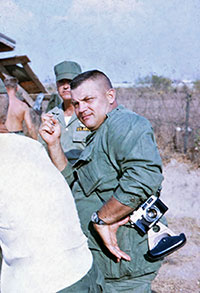
Bill Keller
We lived on the razors edge, a constant adrenaline high which can only be duplicated by the proximity of death. It has been stated many times – and every man and some of the women in this room know it to be true – that you are never so alive as when you are close to death.
Today we are gathered to honor both the living and the dead. There are many of our comrades, our friends, who paid the final price for the freedom of this land, and who experienced the last great adventure – DEATH.
I’m sure that one or more gave some vivid mental picture to each of you. Mine is of someone I really respected but never got to call friend. When we received word of his death four grown combat veterans sat around a table in the mess hall, quietly talking about our departed comrade, with tears running down our cheeks. None of us could obtain any greater eulogy.
Our experiences in Vietnam may make out present existence seem mundane or boring. Life without salt! Many of us, probably every one in this room, have asked of themselves, “Why them – not me – why did I live and they die?” I say to you, that each of us, whether we know it or not, has a mission to perform. Their mission was completed and they went home to the Father!!
Our mission is yet to be fulfilled. There were children who needed to be born, students who needed to be taught, jobs that needed to be done, values that needed to be passed on – our mission on this earth is not yet complete!c
To complete this Memorial to both the living and the dead, I would like to use the words of William Earnest Henley’s immortal poem “INVICTUS:
Out of the night that covers me
Black as the pit from pole to pole
I thank whatever God’s will may be
For my unconquerable soul.
In the fell clutches of circumstance
Under the bludgeonings of fate
My head is bloody but unbowed
I am the master of my fate
I am the captain of my soul
Editor’s note: Bill Keller, Firebird 95, wrote the above note and it was read as part of our very first Memorial Service in February 1993 to the 48 men in attendance. In the almost 17 years since, 5 of those men in that room have died. They are Ned Flecke, Tom Hall, Gary McCall, Charlie Morehouse and Beryl Scott.
14th AVIATION BATTALION CO – LTC Ray Carson
Received from Ray Carson, Jr.
I just wanted to drop you a note to let your members know about the passing of one of your senior officers from 1967-68. My father, Ray Carson, was the aviation battalion commander at Chu Lai. The Rattlers were one of the units under his command. I discovered this when I read the book Firebirds and realized it was talking about his unit and some of the actions he was involved with. I mentioned it to him and he confirmed it was part of his command. From what I little he told me, I know he was involved with the Tet Offensive, resupply at Khe San and the removal of 1200 civilian and special forces troop from a base that was overrun. I think it was called Cam Duc.
He received the DSC for that action. He also received the Silver Star and Bronze Star for valor while there, as well as the air medal with 6 oak leaf clusters. I don’t know how many of your members knew him since he was not a company line officer, but I am sure some of you knew him. He was a humble man and did not talk much about the Vietnam days, although I do know a several stories from his service there. He continued his military career, retiring after 30 years at the rank of full bird.
He died just after his 80th birthday this past November and was buried at Arlington National Cemetery. I figured that his comrades from those days would like to know. Anyone who knew him is free to email me at imagetintr@aol.com if they like. I would be interested in hearing any stories they might have that I can pass on to his grandkids.
RIDE WITH RECOVERY CREW AT YOUR OWN RISK
by David Abel (EM 65-66)
The latest copy of the much appreciated newsletter reminded me of a few incidents 1965-66. Use them if you wish (The statute of limitations has run out).
Five of us squeezed into a Lambretta for a journey to Cholon. This included Glenn Summers, Blas Cavazos, Robert Jacqmein, myself, and another guy from the recovery crew. Since I wasn’t privileged to fly with recovery, I was quite honored. We hit a few places, mostly “on limits,” had many brews, and went looking for a ride home. Apparently there was something going on near one of the bridges towards Bien Hoa, and no one was interested in driving us home. Summers and Cavazos told us to wait in front of the bar (?) and they went scouting. A short time later we heard a speeding vehicle, many shouts, and our two scouts came flying around the corner in a QC jeep with .30 caliber mg on the stand. “Hurry, Hurry, Get In, Get In.” The three of us piled into the back and off we went as fast as that jeep would go. Summers had it floored all the way back to Bien Hoa. Everyone was laughing like hell, and we never slowed down as we flew through the gate. I was surprised that the guards there didn’t fire at us. As far as I know, the quickly repainted jeep is still at the Snake Pit. The recovery crew tried every way that they could think of to mount that .30 on their aircraft, with limited success. Major Gerald Petersen and 1SG John Padgett never asked a question that I was aware of, a sign of outstanding leadership.
I only got to fly with the Rattlers seven or eight times. I suppose that a report of my lack of gunnery skills preceded me. On one trip we landed adjacent to a rubber plantation ENE of Tay Ninh. We still had the standard M-60’s. They (?) pulled all six of the gunners, guns and ammo, and alternated the crew chiefs, l,r,l,r, etc. There was a hot LZ nearby and they needed as many seats as possible (?). The second lieutenant was asked if he could use six more guns on his perimeter. I don’t know who the flight commander was, but I think that the lieutenant kissed him. A platoon sergeant took two of us in tow and led us to the opposite side of the perimeter. He showed me a trail that I was to cover and showed me where I was to place the M-60. I opened the bi-pod and shoved the gun under a little bush that was to be my “cover and concealment.” Unfortunately, the spot was already occupied. I started crawling into position and came nose-to-nose with the biggest spider that I have ever seen. It was white with big red eyes, larger than a mess-kit, and it looked hungry as hell. I immediately abandoned the position and came flying out backwards, and violently encountered the knees of the second lieutenant who had just come over to check the positioning of the gun. He asked me what I was doing and where I thought I was going. The platoon sergeant told me to get back in there and I “respectfully” told them both that there was no way in hell that I was going back under that bush. I described the occupant and how many spec-fours he probably had for lunch. The lieutenant took my flight helmet, crawled under the bush, knocked the beast down, and smashed it with my helmet. The platoon sergeant was laughing so hard that I thought that he was going to have a stroke. He told me that the spiders were white because of eating the bugs off of the rubber trees. He also told me that was the smallest one that he had seen in the area. I did not need to know that. The rest of the day was uneventful, but I stayed wide awake looking for the relatives of that big, hairy beast.
On another flight, someone threw smoke so we opened up on the tree line. As we came jukeing out of the LZ, the pilot had the slick rocking-and-rollin on all three axis simultaneously. What a ride. As we gained a little altitude, we spotted a gentleman, black pajamas and all, running like hell for the woods. Everyone that had a shot opened up on him. He ran, he crawled, he rolled, then back on his feet, running from dust cloud to dust cloud. If I ever find out who that guy was, I’m going to have him buy me a lottery ticket. That was the fastest, luckiest sob on the planet. I hope that he made it.
On another sdip (sunny day in paradise), CWO Willie Hargrove hovered a D-model about four feet off of the ground, in a revetment in the snake pit, while Glenn Summers and I packed sandbags under it. If I remember correctly, we had to go about four high so that the blades would clear the revetment when he set it down. Other than the time I forgot my anniversary, that was the most scared that I have ever been. Summers never broke a sweat. I think that he has straight transmission fluid in place of blood. He is one of the most capable soldiers that I ever served with in my 28 years of service.
Editor’s note: There are very few of us who were regular flight crew members that were not the beneficiaries of the excellent protection and assurance provided by Snakedoctor and its capable crew.
A LETTER TO “LEFTY” FRIZZELL’S CHILDREN
From John Mateyko
Dear Sharon, Randy and Marty,
I recently talked by telephone with your mother about the accident in which your father perished. She shared that for these many years she feared that Marshall may have been at fault. This is a totally false and an unfounded premise.
Permit me to share with you the events of that day and the following Tuesday as I remember them. Please keep in mind that while it was more than 43 years ago, it was the most dramatic and intense moment of my year in Vietnam. Over the years I have recalled it many times and many of the Rattlers who have attended our reunions have said the same thing.
The Rattlers were on a stand down that Sunday morning. We attended a morning memorial service for four crew members and four passengers who the previous Friday died in an aircraft accident. We did so only because we were ordered to, we did not respect the two pilots and could not justify in our minds what they were doing when the aircraft crashed into a high tension tower. We were back in our villa at Bien Hoa when a ‘scramble’ came down from our higher headquarters. We had never used ‘scramble’, that Sunday was the one and only time I had ever heard it used in a military sense. By the time we grabbed our rifles and helmets the company truck was in front to take us to the Snake Pit (our heliport).
By the time we reached our helicopters, the crew chiefs and gunners had the birds armed and ready to go. A quick pre-flight inspection and we took off as individuals and formed in the air into V’s of five. I happened to be in number three slot (middle on the right side) of the first V. We were to pick up infantrymen and transport them to reinforce a unit which was in contact. The first V landed and loaded. When we pulled in take-off power, the resulting wind kicked up dirt and stones and the entire area became an eighty mile an hour sand storm with visibility close to zero. All five aircraft continued and as the helicopters gained translational lift we flew out of the man made storm.
We climbed to about 1,000 feet and circled to the left while waiting for the second V to land, load and join us. Your father was in the #3 slot in the second V. Those of us in the air watched as they pulled take-off power, saw the sand storm envelope the formation and watched the fireball erupt. A couple of helicopters staggered out of the storm. The dust settled and we could see the carnage of the collision. That night, we talked over what must have happened. The pilot of the lead ship announced that he was pulling in take-off power and as the flight moved forward, he stopped without announcing it on the radio. Your father’s aircraft flew into the rotor blades of that lead aircraft. Marshall did not have a chance to avoid the front aircraft, there is no way he was at fault. He was literally in the wrong place at the wrong time.
Two days later at the memorial service, there was not a dry eye amongst us. Our chaplain spoke individually to me and said that he could see the difference in the two memorial services and how they affected the Rattler pilots.
Your father was a good man, a good officer and a good pilot. His life was cut short through no fault of his.
Editor’s note: On 20 February 1966 a collision between two Rattler aircraft killed Marshall Ray (Lefty) Frizzell and Richard P. Lancaster, Jr. This letter to the children of Lefty Frizzell is a prime example of our people, after 43 years, still healing and helping families of our comrades who perished. The aircraft commander of the aircraft that was hit by Frizzell’s ship is deceased.
LIFE IN VIETNAM
The Weekly News Magazine – No 93 – December 31, 1966 – VN $ 20
General Seneff Honors Helicopter Company
BIEN HOA. – Another chapter of heroism was written and placed in the annals of the 145th Combat Aviation Battalion. At a recent awards ceremony, 1st Aviation Brigade Commander, Brigadier General George P. Seneff, Jr., personally presented awards to members of the 71st Assault Helicopter Company <Rattlers>.
In a brief speech General Seneff paid tribute to the Rattlers for their participation in recent combat assault, praising both their individual and collective heroism. The particular engagement manifested the Rattlers: in spite of strong enemy opposition they were able to carry the battle to the enemy and destroy him.
The 71st was hit hard on the first assault, but the Rattlers recoiled and struck back on the second assault. Although the day saw many distinguished acts of bravery and heroism, individual merit contributed to the unity and spirit of cooperation for which the Rattlers are renown.
Accompanied by Colonel Raymond P. Campbell, Commanding Officer of the 12th Aviation Group, and 145th Combat Aviation Battalion CO, Lieutenant Colonel Walter F. Jones, Gen Seneff presented the Air Medal with “V” device, pending approval of the Distinguished Flying Cross, to Warrant Officers Randal W. Billings and William W. Burgner, Jr.
Recipients of the Air Medal with “V” device were: Majors Arnold C. Morris, Nick J. Basic, Glelma O. Helmick, W.J. Hennigan, William Tingler, and Richard L. Williams; Capt. Billy J. Harvey, William E. Keller, Rance A. Kirby, and Arvid J. Shearer; First Lieutenant’s Charles S. Bogle, John E. Cawley, Jr., Dennis W. Hand, and Julius M. Jones; Warrant Officers George F. Bailey, Paul W. Beverung, Richard E. Day, Wilford C. Hingston, David W. O’Quinn, David P. Richard, William J. Robbins, Ronald C. Rudolph, Tommy L. Schneider, Jerry D. Shirley, Paul A. Teelin and Jay S. Wilhelm.
Also presented the Air Medal with “V” device were: Staff Sergeant Carl W. Jordan; Specialist Five’s Sidney M. Clark, Edgar F. Dehart, and James R. Markowski; Specialist Four’s Edward S. Blessing, George D. Brubaker, Larry E. Davis, Richard P. Gill, William L. Gross, Thomas R. Voelkel, Shirley E. Whitehead, Ben M. Williams, James B. Williams, and Samual W. Arthur; Private’s First Class Jerry D. Bowman, Donald E. Bryan, Paul S. Cook, Donald R. Flatten, Robert A. Holzbocher, David McDaniel, Timothy P. Michell, Keith F. Neil, Dennis E. Newton, Earnest Palmieri, Roger R. Patterson, Micheal F. Shields, Danny F. Simmons, Larry T. Smith, and James E. Wynsberge.
One criterion for judging a combat unit is its ability to regroup and counterattack. In spite of receiving extensive combat damage to eleven of fourteen aircraft engaged in the assault, the Rattlers stood ready to resume the battle in the pre-dawn hours of the next day, through the diligent efforts of the 151st Transportation Detachment.
Members of the 151st receiving the Army Commendation Medal were: Chief Warrant Officer Charles R. Morehouse, Warrant Officer Joseph A. Breton, Specialist Five’s Blas Cavazos, JR., and Robert J. Jacqmein; and Specialist Four’s William L. Brousseau, and Felix R. Martinez.
Solemnity dictated the award ceremony and the Rattlers stood resolutely humble, listening to the well earned praise extolled by General Seneff. Although the Rattlers are but one of the many units in Vietnam, they do not have to be told that they are <Second to None>.
Editor’s Note: The story reprinted above was sent to the Association by Jane Morris Beasley. She is the daughter of Rattler 6 Arnold C. Morris, Company Commander of the 71st in late 1966 and early 1967.
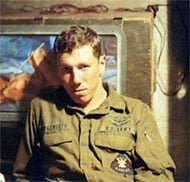
Donald E. Wedgeworth (EM69-70) |
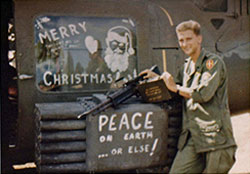
Paul-McPherran-(EM-65-66) |
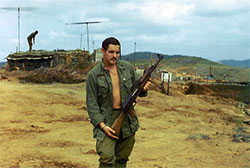
Steve Mackey (EM70-71) |
